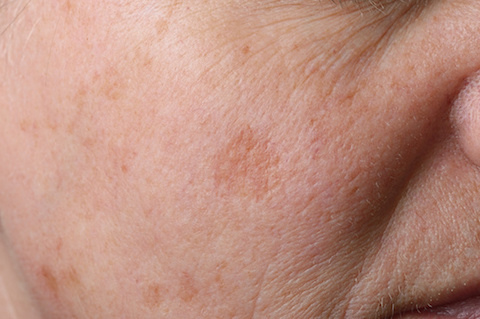
Age spots, brown spots, dark patches…melasma is a skin condition with many monikers. Though it is most commonly known as “age spots.” This very common condition affects 6 million women in the U.S., according to the National Institutes of Health – and I single out women here as 9 of 10 people with melasma are women.
With the rate at which this occurs, chances are you see it fairly frequently in your practice. How do you treat it? What causes it? Most importantly, how do you prevent it?
Inside melasma
In essence, melasma is a form of hyperpigmentation. It appears as patches of brown or gray-brown skin discoloration on the cheeks, forehead, nose, upper lip, and chin, due to overproduction of pigment in the skin.
It’s a common among those who spend a significant amount of time outdoors and don’t use sunscreen, as well as women who are pregnant (it’s often referred to as “pregnancy mask”). As such triggers include the sun, the skin’s natural aging process, certain medications, and hormonal changes.
The primary culprit, however, is UV exposure.
Treating melasma
Though melasma is undesirable, the good news is, it is treatable and in many cases it will fade away on its own. Of course there are ways to support your client in the treatment room and at home.
Typically, regular corrective facials that use natural brightening ingredients and tyrosinase inhibitors, like daisy flower (bellis perennis), will minimize the appearance of melasma. For clients who may be expecting, you’ll want to be cognizant of skin sensitivities, balancing corrective formulas with nourishing ingredients. Our Mommy To Be Facial uses the Derma Peel and Brightening Scrub to gently help correct discoloration while supporting the skin with antioxidants and omega fatty acids from the Antioxidant Complex Serum, Grape Seed Parfait Mask, and Drop of Essence Hydration Drops.
For other clients, depending on their skin needs, ingredients that work well in the treatment room, include:
- Bellis perennis flower (daisy flower) – a gentle, natural brightener derived from daisies.
- Arbutin (L) – a natural plant-based derivative of hydroquinone (HQ) with tyrosinase abilities. Since it is typically more stable and less sensitizing than HQ it’s a great alternative for those with sensitivities.
- Kojic acid – derived from Japanese mushrooms, it works to effectively inhibit melanin synthesis.
- Lactic acid (L) – this keratoyltic AHA has natural brightening abilities, works to smooth skin and improve texture.
- Azelaic acid – a grain- and yeast-derived compound, it helps normalize disordered cell growth, provides antioxidant and anti-inflammatory support, and helps effectively treat acne-related post-inflammatory hyperpigmentation.
- Melanin suppressants – typically a combination of natural lightening ingredients such as kojic acid, L-arbutin, azelaic acid, L-ascorbic acid.
- Daisy flower (bellis perennis) extract – a gentle, yet highly effective natural skin lightener that influences different pathways involved in melanin formation, counteracting age spots and balancing hyperpigmentation.
- Flower acids – a second-generation AHA, flower acids provide brightening benefits and rejuvenation without irritating the skin.
To continue the care at home, a system focused on correcting, rebuilding, and protecting will be key. Start with a good brightening cleanser containing daisy flower and kojic acid. This may be followed by a scrub with brightening ingredients for a deeper, second cleanse. Include a corrective such as retinaldehyde boosted with peptides for rejuvenation and regeneration, as well as a brightening formula. Finally, always include a good sunscreen with a natural mineral blocker like zinc. This is the single most important thing to include in a client’s system.
Some products to turn to include, the Skin Brightening Cleanse, Brightening Scrub, Brightening Pigment Tonic, Mandelic Bright, ChronoPeptide A, Naturale Mega Brightening Serum, and Daytime Defense.
Question: How often do you see melasma in your treatment room and what is your favorite protocol for it?
